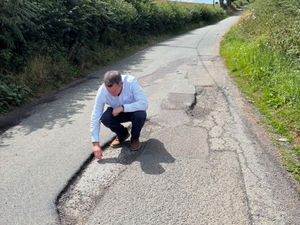Roads minister given tour of problem A5 and A483 in Shropshire and Mid Wales
They are two nationally and even internationally important arterial routes. But through Shropshire the A5 and A483 are woefully inadequate to deal with the thousands of vehicles that use them every day.
That is the view of those who live alongside the trunk roads, those who have to use them for work and leisure and those whose businesses depend on them.
The roads minister was driven from Birmingham accompanied by North Shropshire MP Owen Paterson who has campaigned for more than 20 years for improvements to the A5.
The A5 is part of the Trans-European Highway, linking mainland Europe with Britain and onto Ireland.
The route, from Felixstowe and Dover travels north through England, crosses the Welsh border to reach Holyhead and Ireland.
It is completely motorway and dual carriageway, save for a 20-mile stretch from just north of Shrewsbury to just inside the Welsh border at Ruabon.
Here, apart from the Nesscliffe bypass, the traffic is funnelled into a single carriageway country trunk road with busy road junctions including the notorious Shotatton crossroads and the Oswestry and Chirk bypass roundabouts where hold-ups are becoming the norm.
Traffic also has to cross two high road bridges over the rivers Ceiriog and Dee.
More than 18,000 vehicles a day use the A5 between Shrewsbury and Oswestry, seven per cent of them lorries.
The figures jump to almost 24,000 on the Oswestry bypass, where almost 10 per cent is heavy goods traffic. Slow moving agricultural vehicles add to the problems.
There has been a 33 per cent growth in traffic in the past 25 years.
Mr Paterson said that since the early 1990s 52 people had died from road accidents on the single carriageway A5.
"There have also been countless accidents where people have suffered injury.
"The cost of these accidents is extremely high both in terms of human tragedy and economic cost," he said.
At Oswestry the A5 joins with the A483 which in itself is a major arterial route connecting the north and south Wales.
The Welsh Assembly has carried out improvements to the A483 in Wales but there has been little work on the stretch through Shropshire.
Businessmen told the roads minister that both trunk roads were vital routes into Wales, whether for holidaymakers or for commercial operators.
Mr Paterson said: "The west and Wales have huge opportunities to flourish and these are arterial routes into Wales.
"Shropshire is well placed to benefit but we need the infrastructure of a good road network."
In meetings just off the Oswestry bypass and in the village of Pant, Mr Hayes heard from local people of these experiences of the local road network. Villagers in Pant and Llanymynech have been campaigning for three decades for an A483 bypass and have since seen neighbouring Four Crosses win its bypass because it is across the border in Wales with the work funded by the Welsh Assembly.
Ten years ago it was scheduled in the Government road programme, which then ran out of money.
Parish Councillor, Dilys Gaskill said: "The road gets more dangerous year on year. We desperately need a bypass for our residents."
Emergency service chiefs also told the minister of the reasons behind so many serious and fatal accidents on the A5.
Chief Superintendent Charles Hill said that parts of the road had, in the past, been three-laned, something that had caused many accidents.
Although it was now single carriageway he said frustrated drivers saw what they thought was a chance to overtake on a wide section of the road.
"The gamble doesn't always pay off," he said.
Rod Hammerton chief officer for Shropshire Fire and Rescue Service said the higher than average percentage of heavy goods vehicles on the road also led to more serious accidents with victims more likely to be trapped.
Oswestry Mayor Paul Milner said that as well as having to attend accidents on the A5 the high volume of traffic meant that the emergency services often took longer to respond to general emergency call outs.
Joint working to improve A5 and A483
The Welsh Assembly has agreed to join forces with the Highways Agency to look at ways of improving both the A5 and A483 on the Shropshire/Wales border.
It is the first time that cross-border work will takeget place in an attempt to find a solution to safety worries on the two trunk roads.
Roads minister, John Hayes, is due to meet his Welsh Assembly counterpart, Ken Skates, next week. Mr Skates says he sees both roads as vital for the prosperity of Wales.
The A5 crosses the Welsh border at Chirk taking traffic into North Wales while the A483 is the main, north-south road in the principality, crossing into England at Llanymynech.
Mr Hayes visited the villages of Pant and Llanymynech, split in two by the trunk road, to speak to local residents and councillors on his trip to Shropshire yesterday. He saw at first hand the problems of crossing the busy A483 in the village of Pant where 14,000 vehicles a day use the road.
Councillor Arthur Walpole said: "The school in Pant is close to the road and in the centre of the village. Yet is is so dangerous for children and their parents to walk there. The pavements are incredibly narrow at points, particularly for pushchairs."
Residents told Mr Hayes of the heavy lorries that use the A483, including wagons carrying mobile homes to caravan sites in Mid Wales. "These overhang the pavements they are so wide," Councillor Walpole said.
The roads minister was also told that the road surface of the A483 was in desperate need of renewing. Villagers have been campaigning for a bypass for decades. and now hope that it will find its way onto the next round of the Government's strategic roads scheme which begins in 2020.
Mr Hayes told both A5 and A483 campaigners that he was impressed with their arguments for improvements and said he would take their points back to his department.
"I can not make any promises and I have to look at all the pleas for schemes across the country. But I can promise that I will take everything you say on board."





